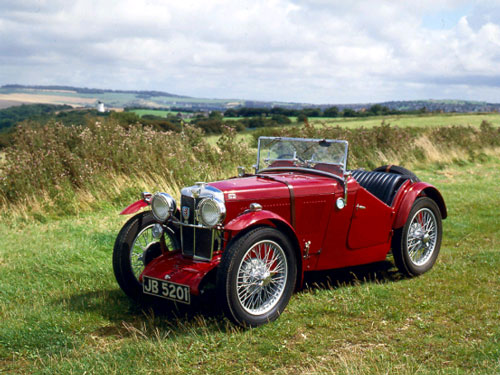
Introduced 1932 - 1934 Number built - 2083
Announced in August 1932 the J2 Midget was outstanding value for just £199 10s. and was within the reach of many enthusiasts of the era. It was based on the successful design of the C type or Montlhery Midget as it was better known, a direct derivative of the M type. From the outset the car represented everything that was right in basic sports car design incorporating such things as a large rear mounted slab type petrol tank with a huge fast fill1 petrol cap, fold flat windscreen with optional aero screens, centre lock wire wheels, remote control gear change, and a spring spoked flat steering wheel. A temperature guage, eight day electric clock, leather securing strap over the bonnet and protective mesh grilles for the headlamps and radiator completed the package of extras for an additional cost of £12 12s.
The chassis layout followed that of the C type incorporating virtually straight side members passing under the rear axle with tubular cross supports. The suspension was half elliptic all round on sliding trunnions. Cable operated brakes utilising 8 drums were quite effective for the size of car. The hand brake lever was mounted on a shaft linked to the foot pedal and four cables which allowed easy adjustment of the brakes. Friction type Hartford shock absorbers were fitted front and rear, with the latter being mounted transversely. The chassis was lubricated by a Tecalemit central greasing system, with the grease nipples neatly grouped on the back of the bulkhead wall. Other features of the chassis included a 12 volt Rotax lighting and starting system, Rudge Whitworth wire wheels and Marles steering gear which was adjustable for rake.
Whereas its forerunner the J1 was offered with 4 seater open or closed bodywork, the J2 was strictly a 2 seater and set the fashion in MG sports cars for many years to come. With its classic two humped' scuttle and low 'cut away doors the car was a masterpiece of simple, functional race bred design and is today considered by many to be one of the classic sports cars of all time. The long bonnet conceals not only the engine but gearbox, foot controls and the legs of the driver or passenger! On lifting the bonnet it seems odd by todays standards to peer into the footwell and cockpit from the engine compartment, but this design had its advantages for ease of maintenance. The tail of the car was short and stubby only extended by the 12 gallon slab tank, and the strapped-on spare wheel. Initially the car was produced with cycle-type front and rear wings, to be replaced a year later with long swept wings.
Power came from the well tried 847cc engine as used on the successful M type which was originally derived from a Wolseley unit. With an eight port crossflow cylinder head and twin SU carburettors, this unit produced a healthy 36 bhp at 5500 rpm, though with only a two main bearing crankshaft, revving the engine to its maximum soon produced premature failure of the flimsy crankshaft. A vertically mounted dynamo was driven off the front end of the crankshaft, with its armature forming part of the overhead camshaft drive. This particular design was a weak point on these engines with seals leaking oil into the dynamo causing embarrassing flat batteries.
The gearbox had four forward speeds unlike the earlier three speed gearboxes of the M and D types; it also had a neat remote gear change enclosed in an alloy casting, bringing the gear lever very conveniently to the driver's hand. The top two ratios were close, giving a good high speed range, whilst first and second gears were sufficiently low for either trials work or the unexpected very steep hill, with a fair step between second and third. A single plate dry clutch transfers the power via a Hardy Spicer prop shaft to the three-quarter floating rear axle.
A supercharged version of the J2 was producer' known as the J3 and had a 750cc unit, in every other respect it was the same as a J2 but with superior performance. The racing variant of the J series was called the J4, this also was basically the same as the J2, but with different steering gear and larger 12" drum brakes as found on the Magna. The J4 was a fast car with several runs of over 100 mph being recorded at Brooklands and there is no doubt that through the continuous development of the J type from the J1 to the J4 it captured the imagination of the sportscar enthusiast. Despite adverse criticism of fuel starvation problems on early J2's and the dynamo oil leak problems mentioned before, careful maintenance gave good reliable service and the cars were in fact able to withstand far more hard use than any other comparable competitor at the time.
Brief technical specifications…
Type: In line, water cooled.
No. of cylinders: 4
Bore/Stroke: 57mm x 83mm.
Capacity: 847cc
Valve Operation: Overhead Camshaft, driven through vertical dynamo.
Carburation: Twin semi downdraught SU.
Compression ratio: 6.2:1.
Power output: 36 bhp at 5500 rpm.
Clutch: Single dry plate.
Transmission: Manual 'crash' 4 forward speeds and reverse.
Frame: Twin side members, tubular cross members.
Wheelbase: 7' 2" Track: 3' 6" front and rear.
Suspension: Front: half elliptic springs, beam axle. Rear: half elliptic springs, live axle.
Length:10'4" Width: 4'3" Height: 4'5"
Brakes: 8" drums cable operated
Tyre size: 277" x 4"
Wheels: Centre lock, detachable wire wheels.
Maximum Speed: 80 mph
Fuel consumption: approx 35 mpg
Acceleration: 0-50 mph; 15 secs.
Number built: Mid 1932 to early 1934; 2083
Cost new in 1932: £199 10s.
We can help you with everything you need to enjoy, maintain and run your MG at reasonable cost: Spares, Insurance, Technical Assistance, Servicing, Restoration, Club runs, Travel opportunities, Local Club activities, Magazine and other quality informative publications, Recommended suppliers, Racing Championship and much more.

